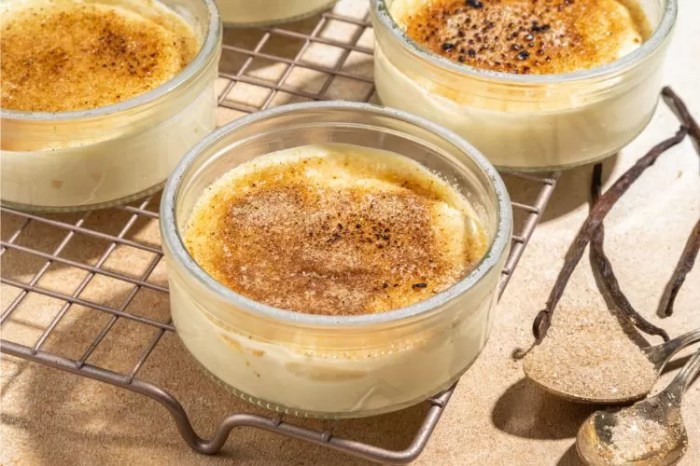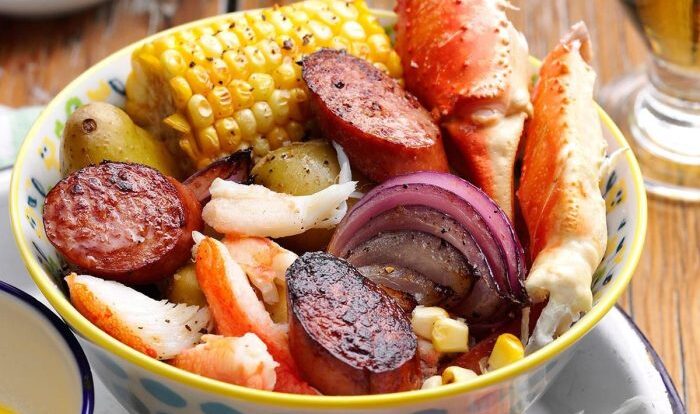
Crab brulee recipe embarks on a culinary adventure that harmonizes the delicate flavors of crab with the rich creaminess of a brûlée, resulting in a masterpiece that tantalizes taste buds and captivates the senses.
From the meticulous preparation of the crab to the precise execution of the cooking techniques, this recipe unveils the secrets to creating an unforgettable dish that blends tradition with modern culinary artistry.
Ingredients and Preparation
The essence of this extraordinary culinary masterpiece lies in the careful selection and preparation of its ingredients. Let’s delve into the specifics:
Crab
The star of the show, the crab, must be of the highest quality. Fresh, succulent crabmeat is essential, and varieties like Dungeness, blue crab, or king crab are highly recommended.
Dairy Products
Rich, creamy dairy products form the velvety base of the brûlée. Whole milk and heavy cream provide a luxurious texture, while eggs contribute to the custard’s delicate structure.
Seasonings
A symphony of flavors is achieved through a judicious blend of seasonings. Fresh herbs like thyme and parsley add a touch of herbaceousness, while a hint of Dijon mustard imparts a subtle piquancy. Nutmeg and paprika provide warmth and a touch of color.
Chicken of the woods, a vibrant orange fungus, offers a unique culinary experience. If you’re looking for a tantalizing recipe, check out the chicken of the woods recipe from Sangamon County. Alternatively, the chicken of the woods recipe from Guilford County provides a slightly different twist on this delectable dish.
Preparation
Preparing the ingredients is crucial. The crabmeat must be cleaned, cooked, and flaked. The dairy products should be whisked together until smooth. Herbs are finely chopped, and seasonings are carefully measured.
Cooking Techniques
The crab brûlée is prepared using a combination of sautéing, baking, and broiling. Sautéing is used to cook the crab and vegetables, while baking sets the custard and creates a firm texture. Broiling is used to caramelize the sugar on top of the brûlée, giving it a crispy and golden-brown finish.
Craving a taste of the forest? Look no further than the chicken of the woods recipe . This vibrant orange fungus offers a meaty texture and earthy flavor that will tantalize your taste buds. Whether you’re a seasoned forager or a culinary novice, this chicken of the woods recipe will guide you through the process of harvesting, cleaning, and cooking this woodland delicacy.
Sautéing
Sautéing is a cooking technique that involves cooking food in a pan with a small amount of fat. In the case of the crab brûlée, the crab and vegetables are sautéed in butter until they are cooked through. Sautéing helps to develop flavor and color in the food.
Baking
Baking is a cooking technique that involves cooking food in an oven. In the case of the crab brûlée, the custard is baked in a water bath until it is set. Baking helps to create a firm and custardy texture in the brûlée.
Broiling
Broiling is a cooking technique that involves cooking food under a high heat source. In the case of the crab brûlée, the brûlée is broiled until the sugar on top is caramelized. Broiling helps to create a crispy and golden-brown finish on the brûlée.
Presentation and Garnishes: Crab Brulee Recipe

Crab brûlée is a visually stunning dish that can be presented in a variety of ways to enhance its appeal. Traditionally, it is served in individual ramekins, allowing the crispy sugar crust to create a dramatic effect when cracked open.
For a more modern presentation, the brûlée can be plated on a larger dish and cut into portions, revealing the creamy interior.
Garnishes
Garnishes play a crucial role in enhancing the visual appeal and flavor of crab brûlée. Fresh herbs such as chives, dill, or parsley add a touch of greenery and freshness. A dollop of crème fraîche or sour cream adds richness and tanginess, while a sprinkle of paprika or cayenne pepper provides a hint of spice.
For a touch of elegance, edible flowers or microgreens can be used as a delicate garnish.
Variations and Substitutions
Craving a unique twist on the classic crab brûlée? Let’s dive into the world of variations and substitutions to spice up your culinary adventure.
By exploring alternative ingredients and techniques, you can transform your crab brûlée into a masterpiece that tantalizes taste buds and sparks culinary conversations.
Seafood Swap
Don’t limit yourself to crab! Experiment with other seafood options like shrimp, lobster, or scallops. Each choice imparts its distinct flavor and texture, creating a new culinary symphony.
Sauce Variations
Elevate your crab brûlée with a range of sauces. Swap the classic hollandaise for a creamy béchamel or a tangy tomato-based sauce. These variations add depth and complexity to the dish.
Cheese Experimentation
Incorporate different cheeses into your crab brûlée to create a harmonious blend of flavors. Try a sharp cheddar for a bold kick or a creamy Brie for a smooth, velvety texture.
Cooking Method Magic
Experiment with various cooking methods to achieve different textures and flavors. Try baking your crab brûlée for a classic custard-like texture or poaching it in a water bath for a more delicate, velvety result.
Historical and Cultural Context

Crab brûlée, a delectable dish that tantalizes taste buds with its rich flavors and creamy texture, has a culinary lineage that spans centuries and continents. Its origins can be traced back to the shores of France, where it emerged as a culinary masterpiece during the 18th century.
The dish’s name, “brûlée,” stems from the French word for “burnt,” alluding to the caramelized sugar topping that gives it its signature golden-brown crust. Initially, crab brûlée was a sweet dessert, but over time, it evolved into a savory dish, showcasing the delicate flavors of crab meat.
Cultural Influences, Crab brulee recipe
Crab brûlée’s journey across borders has been marked by cultural influences that have shaped its preparation and presentation. In the United States, the dish has become a staple of Creole cuisine, where it incorporates bold flavors and spices that reflect the region’s diverse heritage.
In Asia, crab brûlée has found a home in Japan, where it has been adapted to suit local tastes. Japanese crab brûlée often features a delicate dashi broth, adding a subtle umami flavor to the dish.
Regional Variations
As crab brûlée has spread around the world, it has undergone regional adaptations that reflect local ingredients and culinary traditions. In the Chesapeake Bay region of the United States, for instance, blue crab is the star ingredient, while in France, Dungeness crab is commonly used.
In Spain, crab brûlée is often served with a saffron-infused sauce, while in Italy, it may be topped with a creamy béchamel sauce. These variations showcase the adaptability of crab brûlée and its ability to harmonize with diverse culinary cultures.
Final Review

Crab brulee recipe concludes as a testament to the boundless possibilities of culinary exploration. By mastering the techniques and embracing the nuances of flavor, home cooks can elevate their culinary skills and impress their guests with a dish that is both visually stunning and gastronomically satisfying.
Key Questions Answered
What is the ideal crab to use for this recipe?
Blue crab or Dungeness crab are excellent choices due to their delicate flavor and firm texture.
How can I achieve the perfect golden-brown crust on the brûlée?
Use a kitchen torch to caramelize the sugar evenly, ensuring a crisp and flavorful crust.
Can I make this recipe ahead of time?
Yes, you can prepare the crab mixture and refrigerate it overnight. Assemble and brûlée just before serving.
